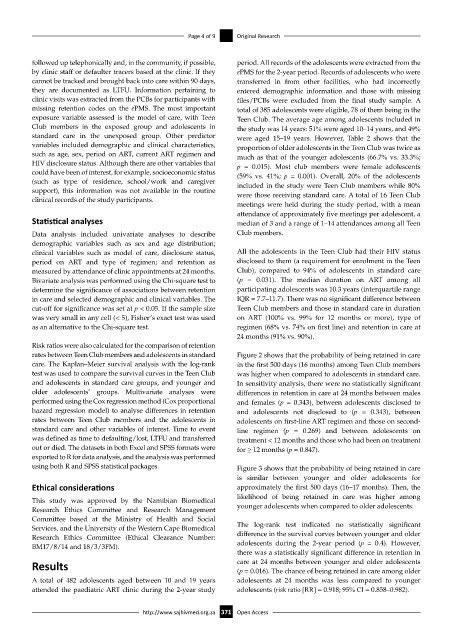Page 379 - HIVMED_v21_i1.indb
P. 379
Page 4 of 9 Original Research
followed up telephonically and, in the community, if possible, period. All records of the adolescents were extracted from the
by clinic staff or defaulter tracers based at the clinic. If they ePMS for the 2-year period. Records of adolescents who were
cannot be tracked and brought back into care within 90 days, transferred in from other facilities, who had incorrectly
they are documented as LTFU. Information pertaining to entered demographic information and those with missing
clinic visits was extracted from the PCBs for participants with files/PCBs were excluded from the final study sample. A
missing retention codes on the ePMS. The most important total of 385 adolescents were eligible, 78 of them being in the
exposure variable assessed is the model of care, with Teen Teen Club. The average age among adolescents included in
Club members in the exposed group and adolescents in the study was 14 years: 51% were aged 10–14 years, and 49%
standard care in the unexposed group. Other predictor were aged 15–19 years. However, Table 2 shows that the
variables included demographic and clinical characteristics, proportion of older adolescents in the Teen Club was twice as
such as age, sex, period on ART, current ART regimen and much as that of the younger adolescents (66.7% vs. 33.3%;
HIV disclosure status. Although there are other variables that p = 0.015). Most club members were female adolescents
could have been of interest, for example, socioeconomic status (59% vs. 41%; p = 0.001). Overall, 20% of the adolescents
(such as type of residence, school/work and caregiver included in the study were Teen Club members while 80%
support), this information was not available in the routine were those receiving standard care. A total of 16 Teen Club
clinical records of the study participants.
meetings were held during the study period, with a mean
attendance of approximately five meetings per adolescent, a
Statistical analyses median of 3 and a range of 1–14 attendances among all Teen
Data analysis included univariate analyses to describe Club members.
demographic variables such as sex and age distribution;
clinical variables such as model of care, disclosure status, All the adolescents in the Teen Club had their HIV status
period on ART and type of regimen; and retention as disclosed to them (a requirement for enrolment in the Teen
measured by attendance of clinic appointments at 24 months. Club), compared to 94% of adolescents in standard care
Bivariate analysis was performed using the Chi-square test to (p = 0.031). The median duration on ART among all
determine the significance of associations between retention participating adolescents was 10.3 years (interquartile range
in care and selected demographic and clinical variables. The IQR = 7.7–11.7). There was no significant difference between
cut-off for significance was set at p < 0.05. If the sample size Teen Club members and those in standard care in duration
was very small in any cell (< 5), Fisher’s exact test was used on ART (100% vs. 99% for 12 months or more), type of
as an alternative to the Chi-square test. regimen (68% vs. 74% on first line) and retention in care at
24 months (91% vs. 90%).
Risk ratios were also calculated for the comparison of retention
rates between Teen Club members and adolescents in standard Figure 2 shows that the probability of being retained in care
care. The Kaplan–Meier survival analysis with the log-rank in the first 500 days (16 months) among Teen Club members
test was used to compare the survival curves in the Teen Club was higher when compared to adolescents in standard care.
and adolescents in standard care groups, and younger and In sensitivity analysis, there were no statistically significant
older adolescents’ groups. Multivariate analyses were differences in retention in care at 24 months between males
performed using the Cox regression method (Cox proportional and females (p = 0.343), between adolescents disclosed to
hazard regression model) to analyse differences in retention and adolescents not disclosed to (p = 0.343), between
rates between Teen Club members and the adolescents in adolescents on first-line ART regimen and those on second-
standard care and other variables of interest. Time to event line regimen (p = 0.269) and between adolescents on
was defined as time to defaulting/lost, LTFU and transferred treatment < 12 months and those who had been on treatment
out or died. The datasets in both Excel and SPSS formats were for ≥ 12 months (p = 0.847).
exported to R for data analysis, and the analysis was performed
using both R and SPSS statistical packages. Figure 3 shows that the probability of being retained in care
is similar between younger and older adolescents for
Ethical considerations approximately the first 500 days (16–17 months). Then, the
likelihood of being retained in care was higher among
This study was approved by the Namibian Biomedical
Research Ethics Committee and Research Management younger adolescents when compared to older adolescents.
Committee based at the Ministry of Health and Social
Services, and the University of the Western Cape Biomedical The log-rank test indicated no statistically significant
Research Ethics Committee (Ethical Clearance Number: difference in the survival curves between younger and older
BM17/8/14 and 18/3/3FM). adolescents during the 2-year period (p = 0.4). However,
there was a statistically significant difference in retention in
Results care at 24 months between younger and older adolescents
(p = 0.016). The chance of being retained in care among older
A total of 482 adolescents aged between 10 and 19 years adolescents at 24 months was less compared to younger
attended the paediatric ART clinic during the 2-year study adolescents (risk ratio [RR] = 0.918; 95% CI = 0.858–0.982).
http://www.sajhivmed.org.za 371 Open Access

